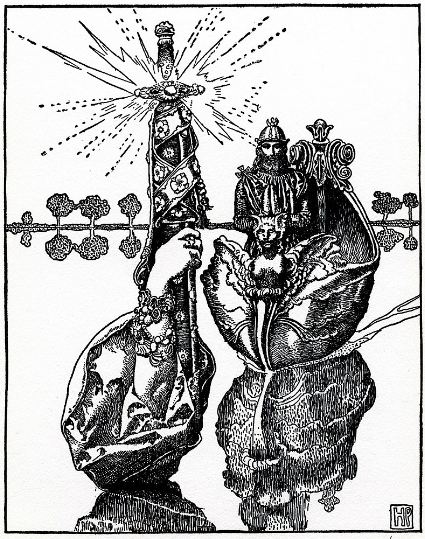Excalibur is King Arthur’s sword in the legendary work Le Morte D’Arthur which was written in 1485 CE by Sir Thomas Malory. The sword was first published as Caliburnus or Caliburn in Geoffrey of Monmouth’sThe History of the Kings of Britain in 1136 CE. Itwas further developed by later writers until Thomas Malory immortalized it in his fiction. In Book IX of the History of the Kings of Britain, Caliburn is first referred to as “the best of swords forged in the isle of Avallon.” It was also mentioned as an object of particular importance by the cleric, Geoffrey of Monmouth, along with Arthur’s other weapons.Ever since the Excalibur was associated with the Arthurian legend. It is called ‘Caledfwlch’ in Welsh, ‘Calesvol’ in Cornish, Caliburnus in Latin and Kaledvoulc’h in Breton.
The name ‘Excalibur’ was actually derived from the Welsh Caledfwlch, a combination of the word ‘Caled’ means “strong” and Bwlch meaning “breach or cleft.” In addition, Caledfwlch appears in many early Welsh plays, such as the tale of Culhwch and Olwen. The name was also used in Welsh adaptation of foreign content such as the Brut Chronicles, also known as the Prose Brut, based on Geoffrey of Monmouth’s legendary history.
Aside from that, Excalibur is often thought to be related to the phonetically similar Caladbolg, a sword wielded by a variety of characters from Irish mythology. Nevertheless, British scholars Rachel Bromwich and D. Simon Evans considered that the borrowing of Caledfwlch from Irish Caladbolg was deemed impossible.Alternatively, they say that both names “may have also emerged at a very early date as generic names for the sword.” The Excalibur then became the personal possession of King Arthur in the British tradition.
In Geoffrey of Monmouth’s Historia Regum Britanniae or The History of the Kings of Britain in 1136’s, he Latinized the name of Arthur’s Sword as Caliburnus. Consequently, the majority of Celtics find Geoffrey’s ‘Caliburnus’ to be a derivative of the lost Old Welsh text in which ‘bwlch’ had not yet been turned to ‘fwlch.’ In the late 15th and early 16th-century Middle Cornish play, ‘Beunans Ke,’ Arthur’s sword was called ‘Calesvol.’ This ‘Calesvol’ is etymologically the same Middle Cornish related to the Welsh ‘Caledfwlch.’Subsequently, ‘Calesvol’ then became Escalibor, Excalibor, and finally the famous Excalibur in Old French documents.
The Sword in the Stone
A number of explanations for Arthur’s possession of the Excalibur are given in Arthurian’s romance. Around 1200, in Robert de Boron’s Merlin, the ‘sword in the stone,’ Arthur won the British throne by taking a sword from an anvil at the top of a stone in the churchyard on Christmas Eve. In this account, as Merlin foretold, the act could not be executed except by the real King, that is divinely appointed or the real heir of Uther Pendragon.As Thomas Malory narrates in his most famous English version of the 15th-century Arthurian tale, ‘Le Morte d’Arthur’: “Whoso pulleth out this sword of this stone and anvil is rightwise king born.”
The Excalibur
In Prose Merlin, part of the French romance’s Lancelot-Grail cycle, also as Pseudo-cycle or the Vulgate cycle, the name of this sword as Excalibur is made clear. In its final cycle, the Vulgate Mort Artu, Arthur orders Griflet to throw the sword into the enchanted Lake at the brink of his death. After two unsuccessful attempts of throwing such a great sword in the Lake, Griflet eventually fulfills the wish of the wounded King, and a hand appears from the Lake to catch it. Although instead of Griflet, in Malory and English tradition, this tale is attached to Bedivere.
Nevertheless, in the Post-Vulgate Cycle and the French volume of Malory, Arthur had breaks the sword known as the Caliburn while fighting King Pellinore. This sword was reported to be given by a Lady in the Lake in exchange for a request, the head of Sir Balin. Both of these versions, the swords were named Excalibur, recorded in Le Morte d’Arthur by Thomas Malory.
